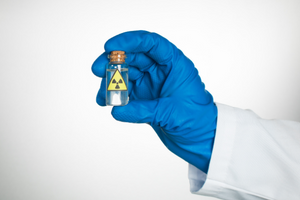Carbon is the most common element on Earth. It creates numerous bonds, mainly with hydrogen and oxygen. There are three known isotopes of carbon: 12C, 13C and 14C. The latter, due to its radioactive properties, is colloquially called radiocarbon. Its most important application is determining the age of geological formations and archaeological objects. In addition, radiocarbon is used to study environmental changes.

Radioactivity of the carbon isotope 14C
Isotopes are a set of atoms of the same element that have identical atomic number and different mass number. The vast majority of naturally occurring elements have more than one isotope. Their properties can be very different. The percentages of individual isotopes also vary significantly.
Elemental carbon has three isotopes: 14C, 13C and 12C. The most common is 12C – over 98%. In the nature, there is much less 13C that can be found. On the other hand, the radioactive isotope of carbon– 14C occurs on Earth in the smallest amount. Its source is the nuclear reactions of thermal neutrons (of cosmic origin) with nitrogen nuclei. They take place in the stratosphere. The carbon isotope 14C decays spontaneously. Beta decay produces non-radioactive nitrogen 14N , an electron, and an antineutrino. Over time, the content of radioactive 14C isotopes in the material decreases. The intensity of the radiation it produces also decreases. The time after which the content of radioactive carbon decreases by half is defined as the half-life (characteristic of radioactive elements). For the 14C isotope of carbon it is 5730 years. Thus, after this time, from one portion of radioactive 14C remains half of it.
Radiocarbon dating
A large part of the carbon isotope 14C, which is accumulated in the atmosphere, is oxidized to form 14CO. When this form reacts with the hydroxyl radical (OH), it is further oxidized to 14CO2. Carbon dioxide, 14CO2 , in turn, is released from the atmosphere into the biosphere and hydrosphere (as a result of, for example, diffusion, dissolution, photosynthesis). 14C radiocarbon is a component of many organic compounds. They assimilate in plants or are dissolved in ocean water. The concentration of the 14C isotope in the atmosphere is several times higher than, for example, in the depths of the ocean. Thus, it becomes a natural isotope tracer. With its help, it is possible to track changes that occur in the natural environment.
One of the most important applications of the 14C isotope is so-called radiocarbon dating. Carbon dioxide containing radioactive 14C penetrates into all living things – plants and animals. Organisms participate in the radiocarbon exchange cycle with the biosphere. Then the content of the 14C isotope is constant. This changes when the organism dies. When an organism dies, it no longer takes up carbon 14C, so its amount steadily decreases. The decay of this isotope takes place at a rate determined by the law of its decay (the decay of 14C atoms over time takes the form of an exponential function). The quoted assumption became the basis for determining the age of archaeological finds, which is called radiocarbon dating (or the radioactive carbon method). Comparison of the ratio of the content of 14C and 12C in the dead organic matter and in the atmosphere allows to determine the radiocarbon age (the time from the death of the organism to the moment of measurement). The conventional radiocarbon age is determined by comparing the content of both carbon isotopes in the test sample and in the modern biosphere standard.
AMS technique for measuring radiocarbon concentration, 14C
Measurement of the content of radioactive carbon 14C in the material is complicated and requires specialized equipment, which makes the whole process expensive. The accelerator technique, AMS, exploits the fact that 14C is slightly heavier compared to 12C (about 1.17 times). A parallel measurement of the 13C content is also made. Accelerator mass spectrometers are used in the AMS technique. The various components of this apparatus, such as the ion source, accelerator, analysing magnet or electrostatic analyser are placed along the sides of a 5 x 5 m square. They are entirely a uniform high-vacuum chamber of a length of about 15 meters. The device can be divided into a low-energy and a high-energy part.
To determine the ratio of individual carbon isotopes, the AMS spectrometer measures the 14C, 13C i 12C atoms that are released from the cathode (made of the test material). Carbon ions (produced in the ion source) are directed to the accelerator. There they are accelerated and hit the analysing magnet. They are then in the drift chamber, which allows the measurement of the electric current of both types of ions. Finally, the ions of the radioactive carbon isotope 14C, after passing through the electrostatic analyser, reach the detector that allows for counting them. The AMS spectrometer is an extremely advanced device. All parts of the apparatus and current operating parameters are controlled by a special PC software and can be controlled from a console.
